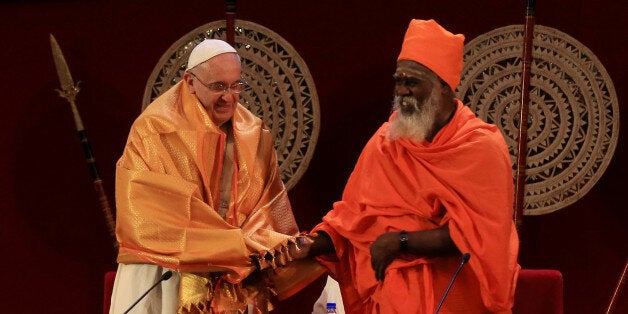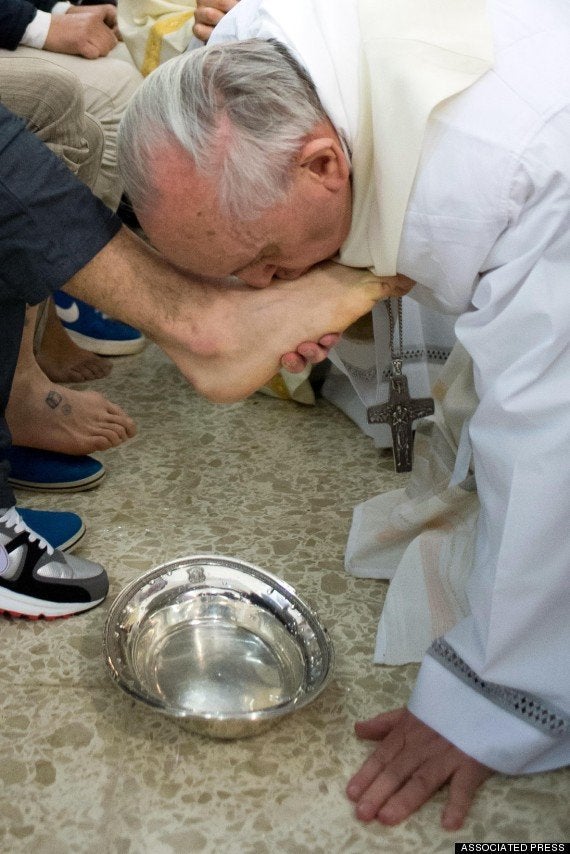

"Following Francis" is a monthly blog on the latest happenings of Pope Francis. It is prepared exclusively for The WorldPost by Sébastien Maillard, Vatican Correspondent for La Croix, Rome
ROME -- Pope Francis flew back Jan. 19th from the Philippines, ending a week-long trip to Asia that he had started in Sri Lanka. Last August, he traveled to Korea. He has not yet been to Africa, to North America nor back to his native Argentina, and he has barely been to Europe outside Italy (except a one-day journey in Albania and four hours in Strasbourg). But he's chosen to visit the Far East twice in less than six months.
The official reason is that his predecessor did "not have time" to go to Asia. Invitations were pending. Jorge Bergoglio found time immediately.
There may some personal reasons for this. When still a young Jesuit, he dreamt of becoming a missionary in Japan but his lung problem was considered too high a risk to allow him to leave Argentina. Now that he is over 78, he is willing to travel more than 14 hours from Manilla -- despite a tropical storm -- to reach the former typhoon-devastated town of Tacloban and, in Sri Lanka, to make a two hour helicopter ride all the way to a Tamil zone severely hurt by the civil war, then fly back another two hours that same day.
Why is Francis expending so much effort to visit a country like Sri Lanka where Catholics represent only 6 percent of the population? Why did he invest so much time and energy in the Philippines where his Church already enjoys an overwhelming position, where 85 percent of the hundred million inhabitants are Catholics?
"Asia is the future of the Church," Pope Francis said to the young archbishop of Manila, Cardinal Luis Antonio Tagle, while receiving wild cheers from the crowd all along the streets.
On the very last day of his journey in the Philippines, he celebrated mass in front of 6 to 7 million people, setting a record in the history of Papal mass rallies. He extolled Filipinos to evangelize Asia as their mission in life.
Jesuits have a special approach when it comes to evangelization in Asia. They have long experience going back to Matteo Ricci -- a Jesuit who tried to evangelize China in the late 16th century and who is very dear to Pope Francis.
For a Jesuit like Bergoglio, the first duty of an evangelist is to respect and adopt the local culture and language, not impose from the outside. In Sri Lanka and in the Philippines, Pope Francis, who only speaks Spanish and Italian, made efforts to express himself in English, the most common language in both countries. At times, he asked the crowd permission to use Spanish -- which was then translated into English -- to speak from the heart and communicate more openly with the assembled crowds.
Overall, he did everything he could in order not to behave as a European -- which he is not. At an inter-religious meeting in Colombo, he wore Hindu clothing that was offered to him. He later entered a Buddhist Temple. The masses he headed used all of the local languages.
Pope Francis understands it is essential in Asia for the Roman Catholic Church not to look too, well, Roman; not to be associated with a form of Westernization of the culture; not to be Eurocentric anymore.
This is why he prefers Asians, such as the Filipinos, to evangelize other areas of the continent and host training for other Asians rather than leave these tasks to outsiders from the West.
He is also opening up the central government of the Church to the whole of Asia and the Pacific, naming cardinals from countries of this region for the very first time, such as Myanmar or the Tonga Islands.
This careful penetration of Asia is not meant to install some sort of conquering Christianity. "Francis is not playing Charlemagne!" jokes an Italian Jesuit close to him.
Whether Catholics stand as a minority, as almost everywhere in Asia, or whether they represent the vast majority, as in the Philippines, the Pope wants them to go out where they can contribute to the harmony of society. He wants them out building bridges between the Sinhalese and Tamil communities, as in Sri Lanka. He want them out helping the street children or typhoon survivors, as in the Philippines, where he warned the local clergy and bishops against the "danger of materialism and staying in their comfort zones." The Church must not grow by proselytization, but by attraction, he often says.
But making two journeys in a row throughout the whole continent (from Korea to the Philippines and Sri Lanka), Pope Francis also means to display that his Church deserves a place in Asia, even if only 3 percent of the total population of the whole region is known to be Christian.
He nonetheless wants Catholics to play a positive role as active, good-willing participant sin the local society without threatening political powers.
Above all, this is an important message for China, which always remains on his mind. The pontiff has carefully avoided meeting with the Dalai Lama, who was in Rome last December. China, which runs its own so-called "patriotic Church" for declared Catholics, remains a black hole in the Holy See's diplomatic ties.
But, as the Pope clearly understands, the future of the Catholic Church in Asia cannot omit China, where Christians (including Protestants) are estimated to be as many as 100 million people. Some predict that, by 2030, China could even become the first Christian country in the world.
That potential future is not lost on this Pope who is looking beyond the West and the European history of Catholicism to fulfill St. Peter's mission and build the Church.
More From Following Francis:
A 'Homebody' Out in the World Who Has Never Been to the United States
A Day in the Life of Pope Francis, Who Lives Behind This Gas Station
Moving the Church Forward on the Modern Family, One Step at a Time
Holy Ghostwriters: Behind the Pope's Tweets and Encyclicals
Is There Life After the Pontificate for Francis?

